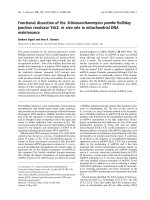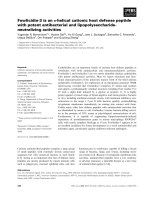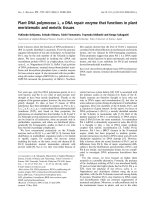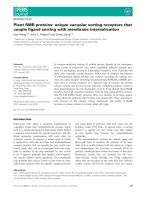Báo cáo khoa học: Plant DNA polymerase k, a DNA repair enzyme that functions in plant meristematic and meiotic tissues docx
Bạn đang xem bản rút gọn của tài liệu. Xem và tải ngay bản đầy đủ của tài liệu tại đây (291.68 KB, 9 trang )
Plant DNA polymerase k, a DNA repair enzyme that functions in plant
meristematic and meiotic tissues
Yukinobu Uchiyama, Seisuke Kimura, Taichi Yamamoto, Toyotaka Ishibashi and Kengo Sakaguchi
Department of Applied Biological Science, Faculty of Science and Technology, Tokyo University of Science, Japan
Little is known about the functions of DNA polymerase k
(Pol k) recently identified in mammals. From the genomic
sequence information of rice and Arabidopsis, we found that
Pol k may be the only member of the X-family in higher
plants. We have succeeded in isolating the cDNA and
recombinant protein of Pol k in a higher plant, rice (Oryza
sativa L. cv. Nipponbare) (OsPol k). OsPol k had activities
of DNA polymerase, terminal deoxyribonucleotidyl trans-
ferase and deoxyribose phosphate lyase, a marker enzyme
for base excision repair. It also interacted with rice prolifer-
ating cell nuclear antigen (OsPCNA) in a pull-down assay.
OsPCNA increased the processivity of OsPol k.Northern
blot analysis showed that the level of OsPol k expression
correlated with cell proliferation in meristematic and meiotic
tissues, and was induced by DNA-damaging treatments.
These properties suggest that plant Pol k is a DNA repair
enzyme which functions in plant meristematic and meiotic
tissues, and that it can substitute for Pol b and terminal
deoxyribonucleotidyl transferase.
Keywords: deoxyribose phosphate lyase; DNA polymerase;
DNA repair enzyme; terminal deoxyribonucleotidyl trans-
ferase.
Ten years ago, only five DNA polymerase species (a to e)
were known, and the in vivo roles of each enzyme were
thought to have been mostly deciphered. Thanks to the
progress of the genome project, however, the story has now
greatly changed. To date, at least 15 classes of DNA
polymerase have been identified in animals, i.e. Pol a, b, c,
d, e, f, g, h, i, j, k, l, m, r and terminal deoxyribonucleotidyl
transferase (TdT), and, based on their properties, the
polymerases are classified into four families, A, B, X and Y
[1]. Although several polymerase species from each of these
can be found in all eukaryotes, some are present only in
multicellular organisms, and others are distributed phylo-
genetically [2]. Consequently, studies on their in vivo roles
have become exceedingly complicated.
We have concentrated particularly on the X-family
enzymes such as Pol b, k, l and TdT [3–5], because their
distribution in multicellular organisms tends to be limited
to specific organs, for example, the nervous system
including the brain, or the testis, ovary and thymus [6–8].
Pol b knockdown mutant mammalian cultured cells
proved viable [9], but in vivo they were lethal because of
central nervous system defects [10]. TdT is associated with
the immune system in the thymus [11]. Some of the X-
family enzymes are therefore thought to have roles not
only in DNA repair and recombination [1], but also in
some unknown system during development of multicellular
organisms. How new members of the X-family, Pol k and
l, function is of great interest. In this report, we focus on
DNA polymerase k (Pol k), a recently identified member
of the X-family in mammalian cells [7,12]. Half of the
peptide sequence of Pol k is arthologous to DNA polym-
erase b (Pol b) from the same mammals. As mammalian
Pol k mRNA is abundantly expressed in testis, like Pol b,
it is thought to play a role in DNA repair synthesis
coupled with meiotic recombination [7]. Unlike Pol b,
however, Pol k has a BRCT domain in the N-terminal
region, which has been proposed to mediate protein–
protein interactions involved in DNA repair and cell cycle
checkpoint regulation on DNA damage [13]. However,
little is known about the actual functions of Pol k and its
differences from Pol b. One of major experimental diffi-
culties is that the distributions and properties of Pol k and
Pol b are similar, and mammalian tissues are too compli-
cated to investigate DNA polymerase knockdown lines
[14].
For this reason, we have focused on higher plant
materials as a possible alternative. Formerly, the presence
of the Arabidopsis ortholog of Pol k was introduced briefly
[7] and we found that higher plants had no Pol b,Poll or
TdT, from the database of rice (Oryza sativa L. cv.
Nipponbare) and Arabidopsis thaliana using the
BLAST
algorithm, with the Pol X domain conserved among family
X enzymes. Therefore Pol k may function in DNA repair
and recombination which are common requirements of
mammals and plants. Moreover, as cells proliferate only in
the meristematic tissues in plants, and not in the other
Correspondence to K. Sakaguchi, Department of Applied Biological
Science, Faculty of Science and Technology, Tokyo University of
Science, 2641 Yamazaki, Noda-shi, Chiba-ken 278-8510, Japan.
Fax: + 81 471 23 9767, Tel.: + 81 471 24 1501 (Ex. 3409),
E-mail:
Abbreviations: Pol, DNA polymerase; PCNA, proliferating cell
nuclear antigen; TdT, terminal deoxyribonucleotidyl trans-
ferase; dRP lyase, 5¢-deoxyribose-5-phosphate lyase;
GST, glutathione S-transferase; BER, base excision repair;
MMS, methylmethanesulfonate.
(Received 15 February 2004, revised 25 April 2004,
accepted 12 May 2004)
Eur. J. Biochem. 271, 2799–2807 (2004) Ó FEBS 2004 doi:10.1111/j.1432-1033.2004.04214.x
mature tissues, the rigid partitioning allows elucidation of
mechanisms of DNA repair in the cells in which DNA or
does or does not replicate.
We report here the characterization of Pol k from a
higher plant, rice, using cDNA and recombinant proteins.
The results suggest that plant DNA Pol k is a DNA repair
enzyme which functions in plant meristematic and meiotic
tissues.
Materials and methods
Plant materials
Rice plants (Oryza sativa L. cv. Nipponbare) were grown in
a growth cabinet under a 16 h day/8 h night cycle at 28 °C.
Suspension-cultured cells were cultured as described previ-
ously [15].
Molecular cloning of
O. sativa
DNA Pol k (OsPol k)
The rice database was searched using the
BLAST
algorithm.
One sequence (GenBank accession number AP004995)
was identified that encodes a predicted protein with high
similarity to A. thaliana Pol k (AJ289628). The cDNA of
this gene, named OsPol k, was isolated from rice mRNA
using the RNeasy Plant Mini kit (Qiagen), and was
amplified with the SuperScript One-Step RT-PCR System
(Invitrogen). The nucleotide sequence data reported in this
paper are now available in the DDBJ/EMBL/GenBank
nucleotide sequence databases with the accession number
AB099525. Site-directed mutations were introduced into
OsPol k by a PCR-based method as described previously
[16].
Overexpression of OsPol k protein in
Escherichia coli
The OsPol k protein, which contained a six-histidine
C-terminal tag, was overexpressed and purified as follows.
The sequence of the OsPol k coding region was cloned
into the pET21a expression vector (Novagen), which was
transfected into BL21 (DE3) (Novagen) bacteria in
500 mL Luria–Bertani medium containing 50 lgÆmL
)1
ampicillin. Cells were grown to an absorbance of 0.8, and
isopropyl b-
D
-thiogalactoside was added to a final
concentration of 1 m
M
. Cells were harvested after 3 h
by centrifugation at 3000 g for 10 min. Cell pellets were
resuspended in 4 mL ice-cold binding buffer (20 m
M
Tris/
HCl, pH 7.9, 0.5
M
NaCl, 5 m
M
imidazole, 0.1% Nonidet
P40) and sonicated with 20 bursts of 10 s each. Cell
lysates were centrifuged at 39 000 g for 20 min, and the
soluble protein fraction was collected as the crude extract
andloadedonto10mLHis-BindResin(Novagen).The
column was washed with 50 mL binding buffer and then
with 50 mL wash buffer (20 m
M
Tris/HCl, pH 7.9, 0.5
M
NaCl, 60 m
M
imidazole, 0.1% Nonidet P40), and the
bound protein was eluted with 30 mL elution buffer
(20 m
M
Tris/HCl, pH 7.9, 0.5
M
NaCl, 1
M
imidazole).
The eluted protein was dialyzed against buffer A (50 m
M
Tris/HCl, pH 7.5, 1 m
M
EDTA, 5 m
M
2-mercaptoetha-
nol, 10% glycerol, 0.1% Nonidet P40), and the dialysate
was loaded on to a HiTrap Heparin column (Amersham
Pharmacia Biotech) equilibrated with buffer A. After
being washed, the fraction was collected with 20 mL of a
linear gradient of 0–0.5
M
NaCl in buffer A. The eluted
OsPol k protein was dialyzed against buffer A and used in
the subsequent experiments.
Standard DNA polymerase assay
A DNA polymerase assay was performed as described in
a previous report [2]. The assay mixture (20 lL) con-
tained: 50 m
M
Tris/HCl (pH 7.5) with 1 m
M
MnCl
2
,
1m
M
dithiothreitol, 40 l
M
dTTP, 10 lCiÆmL
)1
[
3
H]TTP,
1pmol OsPolk,20lgÆmL
)1
oligo(dT)
12)18
,40lgÆmL
)1
poly(dA) or poly(rA) and 15% (v/v) glycerol. Incubation
was carried out at 37 °C for 30 min, and then the reaction
mixtures were spotted on pieces of DE81 filter paper,
washed sequentially four times with 5% (w/v) Na
2
HPO
4
,
twice with distilled water, and then twice with 100%
ethanol. After being dried, the radioactivity of each piece
was measured in a toluene-based scintillator using a
Beckman liquid-scintillation counter. One unit of DNA
polymerase activity was defined as the amount of enzyme
catalyzing the incorporation of 1 nmol dTTP in 60 min
at 37 °C.
3¢fi
fi
5¢ exonuclease assay
OsPol k (1 pmol) was incubated with 100 fmol DNA
substrate with 5¢-end
32
P-labeled primer in 20 lL reaction
mixture containing 50 m
M
Tris/HCl (pH 7.5), 5 m
M
MgCl
2
,and1m
M
dithiothreitol at 37 °Cfor20min.The
reaction was stopped by the addition of gel loading buffer
(95% formamide, 20 m
M
EDTA 0.02% bromophenol blue
and xylene cyanol), and analyzed by electrophoresis in a
10% polyacrylamide gel and visualized by autoradiography.
DNA substrate used in this assay is a d15:d21-mer primer/
template. The sequences are 5¢-ACTGGAGATCTGC
AT-3¢ and 5¢-TGAAGCATGCAGATCTCCAGT-3¢.
Misincorporation assay
The four template/primer structures used, which differ
only in the first template base, are shown in Fig. 2B.
A1m
M
Mn
2+
-activated nucleotide insertion on each
5¢-labelled DNA substrate was analyzed in the presence of
either the complementary nucleotide (0.1 l
M
)oreachof
the three incorrect dNTPs (100 l
M
). 5¢-End labeling was
performed by T4 polynucleotide kinase (Takara Bio Inc.)
using [c-
32
P]dATP (3000 CiÆmmol
)1
; Amersham). After
incubation for 15 min at 37 °C in the presence of 50 n
M
OsPol k, extension of the 5¢-labeled strand was analyzed
by electrophoresis in a 8
M
urea/10% polyacrylamide gel
and autoradiography.
Measurement of processivity
A d27:d52-mer primer/template was assayed in a final
volume of 20 lL containing 50 m
M
Tris/HCl (pH 7.5),
0.2 mgÆmL
)1
BSA, 1 m
M
dithiothreitol, 1 m
M
MnCl
2
,5l
M
each unlabeled dNTP, 1 pmol OsPol k, 0.5 pmol 5¢-labeled
DNA template and 40 pmol unlabeled poly(dA)/
oligo(dT)
12)18
as the trap. First, the reaction components
were mixed in the absence of dNTPs and the trap. Next, the
2800 Y. Uchiyama et al.(Eur. J. Biochem. 271) Ó FEBS 2004
reaction was started by adding the dNTPs and the trap.
Mixtures were incubated for 5 min at 37 °C in the presence
(5 pmol) or absence of rice proliferating cell nuclear antigen
(OsPCNA), and reactions were stopped by the addition of
gel loading buffer (95% formamide, 20 m
M
EDTA 0.02%
bromophenol blue and xylene cyanol), and analyzed by
electrophoresis in a 10% polyacrylamide gel and visualized
by autoradiography. We have checked the effectiveness of
the trap. The mixture in the absence of OsPCNA was also
incubated for 10 min at 37 °C. In this case, the product size
was not increased. OsPCNA was expressed and purified as
described previously [17].
Terminal transferase assay
A single-stranded 75-mer oligonucleotide was assayed in a
final volume of 20 lL containing 50 m
M
Tris/HCl (pH 7.5),
0.2 mgÆmL
)1
BSA, 1 m
M
dithiothreitol, 0.5 m
M
MnCl
2
,
0.2 l
M
single-stranded 75-mer (3¢-OH ends). The sequence
of 75-mer oligonucleotide is 5¢-AGCTACCATGCCT
GCACGAAGAGTGCGTATTATGCCTACACTGGA
GTACCGGAGCATCGTCGTGACTGGGAAAAC-3¢.
[
3
H]dTTP (10 l
M
;10CiÆmmol
)1
) and enzymes were added
as indicated in the figure legends, and incubated for 30 min
at 37 °C. The reaction mixtures were spotted on pieces of
DE81 filter paper. After being washed and dried, the
radioactivity of each piece was measured in a toluene-based
scintillator using a Beckman liquid-scintillation counter.
5¢-Deoxyribose-5-phosphate (dRP lyase) activity assay
A 21-mer oligonucleotide containing an AP site at
position 10 (5¢-CCTGCCCTGAPGCAGCTGTGGG-3¢;
Trevigen, Gaithersburg, MD, USA) was labeled at the
3¢-end with terminal deoxynucleotidyltransferase (Takara)
using [a-
32
P]ddATP (3000 CiÆmmol
)1
; Amersham) and
annealed to its complementary oligonucleotide (Trevigen).
This labeled double-stranded substrate (1 pmol) was
treated with human AP endonuclease (1 unit; Trevigen)
for 1 h at 37 °Cin20lL buffer containing 10 m
M
Hepes/
KOH, pH 6.5, 100 m
M
KCl and 10 m
M
MgCl
2
, thus
generating the substrate for dRP lyase activity (Fig. 3A).
Reaction mixtures (20 lL) contained 50 m
M
Hepes,
pH 7.4, 5 m
M
MgCl
2
,2m
M
dithiothreitol, and 1 pmo-
lÆlL
)1
concentration of the labeled substrate as described
in the previous section. The reaction was initiated by
adding 50 n
M
(final) OsPol k or rat Pol b, and incubation
was for 15 min at 37 °C. NaBH
4
wasthenaddedtoa
final concentration of 340 m
M
, and the reaction continued
for 30 min on ice. Stabilized DNA products were ethanol-
precipitated in the presence of 0.1 lgÆmL
)1
tRNA,
resuspended in 10 lL gel loading buffer (95% formamide,
20 m
M
EDTA, 0.02% bromophenol blue and xylene
cyanol), and analyzed by electrophoresis in a 20%
polyacrylamide gel and visualized by autoradiography.
Recombinant rat Pol b was expressed and purified as
described previously [4].
Fig. 1. Comparison of predicted amino acid
sequences of OsPol k, human Pol k, human
Pol b (A) and phylogenetic tree constructed by
the UPGMA method, based on the amino acid
sequences of the DNA polymerase domains of
OsPol k and the other X-family DNA poly-
merases (B). (A) OsPol k has a BRCT
(BRCA1 C-terminal) domain at the N-ter-
minal region similar to human Pol k and has
the Pol domain that is conserved among
X-family members. (B) Horizontal distances
are proportional to evolutionary divergence
expressed as substitutions per site.
Ó FEBS 2004 Plant DNA polymerase k (Eur. J. Biochem. 271) 2801
Pull-down assay
His-tagged OsPol k (1 lg) and glutathione S-transferase
(GST)-fused OsPCNA (1 lg) or GST (1 lg) were incubated
with GST–Sepharose-4B beads. The beads were then
washed with 10 vol. of the manufacturer’s buffer, and the
amount of protein present in the affinity column was
quantified by Western blotting. The immunoblot was
probed with polyclonal antibody to His-tag (Medical and
Biological Laboratories Co., Ltd).
Other methods
Phylogenetic analysis was performed based on the amino
acid sequence by the UPGMA method using
GENETYX MAC
var. 10 (Software Development Co. Ltd, http://
www.sdc.co.jp/genetyx). DNA polymerase domains of
various X-family DNA polymerases were aligned and used
to produce the tree. Northern blotting analyses were
performed as described previously [18]. Blots were quanti-
fied with an NIH imaging analyzer.
Results
Identification of OsPol k and comparison with other
eukaryotic DNA polymerases of the X-family
As described in the Introduction, there may be only one
kind of the X-family polymerase in higher plants, and it is
homologous to Pol k. Molecular cloning of a Pol k-
homologous cDNA (OsPol k) from rice cells was carried
out as described. OsPol k was found to encode a predicted
product of 552 amino acid residues with a molecular mass of
60.9 kDa. OsPol k protein contains a BRCT domain at the
N-terminus and a Pol X domain at the C-terminal region,
similar to the overall domain organization of mammalian
Pol k. The nucleotide sequence data reported in this paper
have been lodged in the DDBJ nucleotide sequence
database with the accession number AB099525. The
OsPol k gene was mapped to chromosome 6 and was
shown to contain 14 exons and 13 introns in a total genomic
segment of 5.1 kb. We also succeeded in cloning Pol k
cDNA from A. thaliana (AtPol k) to assess universality.
Similar to OsPol k structurally, AtPol k encodes a predicted
product of 529 amino acid residues with a molecular mass of
59.6 kDa.
The deduced amino acid sequence of OsPol k was
compared with those of other known eukaryotic X-family
DNA polymerases and found to show 60.5% sequence
identity with AtPol k, and 29.6% with human Pol k.As
shown Fig. 1A, OsPol k protein shows a high degree of
conservation in the C-terminal DNA polymerase domain
(37.3% identity with DNA polymerase domain of human
Pol k), suggesting that the DNA polymerase activity of this
enzyme may be important for plant cells. On the other hand,
the N-terminal BRCT domain proposed to mediate
protein–protein interactions involved in DNA repair and
cell cycle checkpoint regulation on DNA damage [13] shows
a lower degree of homology to human Pol k. To determine
the phylogenetic relationship between OsPol k and other
X-family DNA polymerases, a tree was drawn based on the
amino acid sequences of the DNA polymerase domains
Fig. 2. DNA polymerase activity of OsPol k protein. (A) Multiple
amino acid alignment of a portion of the polymerization active site
with the other X-family DNA polymerases. White letters over black
background represent invariant residues among X-family DNA
polymerases. The asterisk indicates changed amino acids. (B) SDS/
PAGE analysis of OsPol k wild-type (lane l) and D400A D402A
mutant (lane 2). The concentration of the SDS/polyacrylamide gel was
10%, and staining was with Coomassie Brilliant Blue (CBB). (C)
Standard DNA polymerase activities of OsPol k wild-type and D400A
D402A mutants were measured under the conditions described in
Materials and methods.
2802 Y. Uchiyama et al.(Eur. J. Biochem. 271) Ó FEBS 2004
(Fig. 1B). For this purpose, distance matrices were gener-
ated, using the unweighted pair-group method with arith-
metic averages (UPGMA). The Pearson product–moment
correlation coefficient was used to estimate the agreement
between the original distance matrix and that obtained
directly from the dendrogram. Pol k was confirmed to be
highly conserved among the plant and animal kingdoms
(Fig. 1B), suggesting that they have independently evolved
to occupy a particular functional niche.
DNA polymerase activity of OsPol k protein
The OsPol k protein was overexpressed in E. coli and
purified as described in Materials and Methods. This
protein was purified to near-homogeneity as shown by
SDS/PAGE analysis (Fig. 2B, lane 1) and was devoid of
nuclease contaminants, as tested in nuclease assays (data not
shown). The specific activity of the wild-type protein was
7243 UÆmg
)1
under our standard conditions. To confirm
that the activity was associated with OsPol k protein, we
prepared a mutant with two substitute amino acids,
Asp400Ala and Asp402Ala. These amino acids are highly
Fig. 3. DNA synthesis catalysed by OsPol k. (A) OsPol k preferentially incorporates complementary nucleotides. Four different template/primer
structures were used, differing in the first template base. Reactions were carried out in the presence of 50 n
M
OsPol k and 1 m
M
MnCl
2
as a source
of activating metal ions. Extension of the labeled (*) primer strand in the presence of either the correct (0.1 l
M
)ortheincorrect(100 l
M
)dNTPwas
analyzed by 8
M
urea and 10% PAGE and autoradiography. (B) TdT activity was measured under the conditions described in Materials and
methods. Commercial TdT (Takara) was assayed as a positive control. (C) In vitro interaction between OsPCNA and OsPol k.OsPolk-His was
mixed with GST-OsPCNA or GST in NaCl/P
i
buffer at room temperature for 1 h, and then with a column of GST–Sepharose-4B beads. The beads
were washed and eluted and the amount of protein was quantified by Western blotting. The immunoblot was probed with a polyclonal antibody to
His-tag. (D) DNA polymerase activity of OsPol k on a d27:d52-mer primer/template under processive conditions in the absence (lanes 1 and 2) or
presence (lanes 3 and 4) of OsPCNA. Reactions were carried out in the presence of 1 pmol OsPol k,0.5pmol5¢-labeled DNA template, and
40 pmol unlabeled poly(dA)/oligo(dT)
12)18
as the trap.
Table 1. DNA polymerization properties of OsPol k. ddTTP, 2,3-
dideoxythymidine-5-triphosphate. The activity with poly(dA)/oli-
go(dT) under standard conditions was expressed as 100%. Specific
activity of OsPol k was 0.435 UÆ(pmol enzyme)
)1
.
Activity
(%)
dTTP incorporated
(pmol)
Mn
2+
(1 m
M
) 100 217
–Mn
2+
<1 ND
–Mn
2+
+Mg
2+
(1 m
M
)38 82
–Mn
2+
+Mg
2+
(5 m
M
) 70 152
KCl (100 m
M
)4189
NaCl (100 m
M
)3576
Aphidicolin (100 lgÆmL
)1
) 102 221
N-Ethylmaleimide (20 l
M
) 94 204
ddTTP (5 l
M
) 54 117
ddTTP (10 l
M
)1226
Templates
Poly(dA)/oligo(dT) 100 217
Poly(rA)/oligo(dT) 24 52
Poly(dA-dT) 5 11
Activated DNA 49 106
Ó FEBS 2004 Plant DNA polymerase k (Eur. J. Biochem. 271) 2803
conserved among various organisms and therefore must be
very important (Fig. 2A). This control protein was purified
to near-homogeneity as shown by SDS/PAGE analysis
(Fig. 2B, lane 2). In this case, the OsPol k D400A D402A
mutants possess extremely low polymerization activity
(Fig. 2C). This indicates that the activities of OsPol k were
intrinsic. The biochemical properties of OsPol k are shown
in Table 1. As expected, it required activation with metal
ions, Mn
2+
being more efficient than Mg
2+
.Wealso
investigated the effects of DNA polymerase inhibitors on
the DNA polymerase activity of OsPol k. Strong inhibition
was noted with 2,3-dideoxythymidine-5-triphosphate, a
known inhibitor of mammalian DNA polymerases b and
c, but the enzyme was not sensitive to aphidicolin and
N-ethylmaleimide, both of which are inhibitors of DNA
polymerase a, d,ande.OsPolk preferentially utilized
poly(dA)/oligo(dT)
12)18
as a template. These results are
similar to those reported for mammalian Pol k [19–21].
Figure 3A shows the capacity of OsPol k to catalyze
faithful DNA synthesis. Each of the four dNTPs was
assayed individually as a substrate for incorporation
opposite the four possible template bases, in the presence
of Mn
2+
ions. OsPol k preferentially inserted the correct
dNTP, but some was slightly misinserted opposite the
wrong template bases.
Human Pol k possesses terminal deoxyribonucleotidyl
transferase (TdT) activity [22]. We investigated whether
OsPol k had this activity. As shown in Fig. 3B, OsPol k has
weak TdT activity: 2 pmol OsPol k incorporated 0.3 pmol
dTMP per 30 min. In this assay, commercial TdT (Takara)
was assayed as a positive control.
Recently, a direct interaction of human PCNA with
human Pol k was shown which stimulates its processivity
[23]. To investigate whether OsPol k directly interacts with
rice PCNA (OsPCNA), a pull-down assay was performed.
We expressed GST and OsPCNA-fused GST at the
N-terminus in E. coli, and then purified them using GST–
Sepharose-4B bead column chromatography. Each protein
was mixed with His-tagged OsPol k and a GST–Sepharose-
4B column. The fractions washed and eluted with glutathi-
one were electrophoresed and then stained with an antibody
against the His-tag. As shown in Fig. 3C, OsPol k appeared
to bind to GST-fused OsPCNA, but not to GST only. In
addition, we investigated whether this interaction affected
the activity of OsPol k. Under processive conditions
(Fig. 3D), i.e. in the presence of an excess of cold
poly(dA)/oligo(dT)
12)18
as a trapping reagent, OsPol k
showed a processivity of one or two nucleotides on a
d27:d52-mer primer/template, which was increased to about
four nucleotides in the presence of OsPCNA (Fig. 3D).
Under standard (distributive) conditions, OsPCNA had no
effect on OsPol k activity (data not shown). These results
indicate that, similar to human Pol k,OsPolk interacts
with OsPCNA, and its processivity is thereby stimulated.
OsPol k has dRP lyase activity
Recently, human Pol k has been shown to have dRP lyase
activity, so it may participate in base excision repair (BER)
similarly to mammalian Pol b [24]. BER, considered to be
an essential pathway for the elimination of single damaged
bases in DNA [25], is initiated by the removal of the
modified base by a DNA glycosylase. The resulting AP site
is recognized and incised by an AP endonuclease [26].
Removal of the remaining dRP residue is catalyzed by a
dRP lyase activity, and the gap is filled by a DNA
polymerase such as Pol b [27]. To test the ability of OsPol k
to remove a dRP group, we used a 21-mer double-stranded
oligonucleotide containing an AP site at position 10. As
described in Materials and Methods, the AP site-containing
strand was 3¢-end-labeled with [a-
32
P]ddATP, annealed to
its complementary strand and treated with human AP
endonuclease to release a dRP-containing substrate
(Fig. 4A). This substrate was incubated in the absence
(control) or presence of either rat Pol b or OsPol k.
Figure 4B shows that both enzymes removed the dRP
moiety, as detected by the reduction in size of the labeled
substrate. This suggests that OsPol k plays a central role in
plant BER, because plants are thought to have no Pol b,
Fig. 4. OsPol k exhibits dRP lyase activity. (A) Schematic represen-
tation of a dRP lyase reaction. A 21-mer double-strand oligonucleotide
containing an abasic site at position 10 in one strand is treated with
human AP endonuclease to release a dRP-containing substrate. This
dRP moiety is cleaved by dRP lyase activity. (B) Autoradiogram
illustrating OsPol k dRP lyase activity. Lane 1, no protein control; lane
2 and lane 3, DNA was incubated with OsPol k and rat Pol b,
respectively.
2804 Y. Uchiyama et al.(Eur. J. Biochem. 271) Ó FEBS 2004
Pol c or Pol i, which have dRP lyase activity in mammalian
cells.
Expression levels of
OsPol k
correlated with cell
proliferation
To determine the expression pattern of OsPol k in various
organs, Northern blot hybridization was performed
(Fig. 5A). Total RNA samples isolated from various organs
of 50-day-old and 150-day-old rice plants were blotted and
probed with
32
P-labeled OsPol k cDNA. The probe for
OsPol k was a sequence of 700 bp from the C-terminus.
Two kinds of transcripts thought to be splicing variants
were mostly detected in the region of the shoot apical
meristem and panicle (lanes 1 and 5 in Fig. 5A), and showed
moderate expression in the roots, root apices, flag leaves and
young leaves (lanes 3, 4, 6 and 7). In the mature leaves, no
expression was evident (lane 2). The young leaves have
meristem to increase the leaf width, while mature leaves
have no proliferating cells. The panicle contains meiotic
tissues. These results suggest that transcription of OsPol k
reflects the level of cell proliferation and is perhaps related to
meiosis.
OsPol k was actively transcribed in rice cells in suspen-
sion culture (lane 1 in Fig. 5B). When cell proliferation was
temporarily halted for 6 or 10 days by removal of sucrose
from the growth medium, the level of OsPol k expression
was significantly reduced (lanes 2 and 3). When the growth-
halted cells began to re-grow after addition of sucrose to the
medium, OsPol k was again expressed at high levels (lane 4).
Fig. 5. Expression of OsPol k. (A) Northern blot analysis of OsPol k in different organs of rice. Each lane contained 20 lg total RNA isolated from
shoot apical meristem (SAM; lane 1), a mature leaf (lane 2), a young leaf (lane 3), a root (lane 6) or root apex (lane 7) from an 50-day-old rice
plant, and Flag leaf (lane 4) or panicle (lane 5) from about 150-day-old rice plant. The blot was probed with
32
P-labeled OsPol k cDNA (upper
panel). Similar amounts of RNA were loaded in each lane as confirmed by ethidium bromide staining (lower panel). (B) Effects of sucrose starvation
on the expression levels of OsPol k. Rice cells were cultured in suspension for 6 days with sucrose (lane 1) or without sucrose (lane 2), and for
10 days without sucrose (lane 3). Lane 4, cells cultured first for 6 days without sucrose, and then for a further 4 days after sucrose had been added to
the medium. Aliquots of 20 lg total RNA isolated from the cultured cells were separated on a 1.2% agarose gel containing formaldehyde, and then
blotted. The blot was probed with
32
P-labeled OsPol k cDNA. Similar amounts of RNA were loaded in each lane as confirmed by ethidium
bromide staining (lower panel). (C) 14-day-old rice plants were exposed to 25 JÆm
)2
UV-B. After UV-B exposure, plants were kept for 0 h (lane 1),
1 h (lane 2), 2 h (lane 3) or 4 h (lane 4) in the dark. Total amounts of OsPol k mRNA were determined using an imaging analyzer and expressed
relative to the transcripts 0 h after irradiation. (D) 0.25 l
M
MMS was added to rice suspension cultures. Next, cells were kept for 0 h (lane 1), 0.5 h
(lane 2), 1 h (lane 3) or 2 h (lane 4) in the dark. Total amounts of OsPol k mRNA were determined using an imaging analyzer and expressed relative
to the transcripts 0 h after treatment.
Ó FEBS 2004 Plant DNA polymerase k (Eur. J. Biochem. 271) 2805
These results indicated that OsPol k expression correlates
with cell proliferation.
Effects of DNA-damaging treatments on the levels
of
OsPol k
expression
In addition, we investigated the effects of DNA-damaging
treatments, such as UV and methylmethanesulfonate
(MMS), on the expression levels of OsPol k. The 14-day-
old rice seedlings were UV-irradiated at 25 JÆm
)2
, followed
by incubation for 1–4 h (Fig. 5C). The cultured rice cells
weretreatedwith0.25l
M
MMS by adding to the dishes,
followed by incubation for 0.5–2 h (Fig. 5D). The levels of
OsPol k expression were increased by both treatments
(Figs 5C.D). The induced expressions reached maximum
levels at 4 h and 1 h after treatments with UV and MMS,
respectively. These observations suggest that the gene
product was involved in DNA repair.
Discussion
For the past 10 years, we have focused on elucidating the
roles of each of the eukaryotic DNA polymerases
[2–5,18,28–31]. In this study, we took advantage of the
characterisitcs of higher plants for this purpose and first
succeeded in preparing cDNA and the recombinant protein
(OsPol k). To our knowledge, this is the first report to focus
on a plant homolog of the X-family polymerases, and Pol k
may be universally present in higher plants as the only
member of this family. Assessment of the phylogenetic
relationship between OsPol k and other X-family DNA
polymerases showed that Pol k may have independently
evolved to occupy a particular functional niche in the plant
and animal kingdoms. Interestingly, Pol k is more closely
relatedtoPolb than Pol l and TdT, which have a BRCT
domain similar to Pol k (Fig. 1B), suggesting that Pol k, l
and TdT are ancestor polymerases descended from a
common prototype, and Pol b has diversified in evolution.
Why Pol l and TdT should be absent from higher plants
remains unclear. Either they evolved after animals arose, or
the genes might have been lost during the evolution to
plants.
The recombinant OsPol k protein showed DNA poly-
merase and TdT activities (Figs 2C and 3B). It is very
interesting that plant Pol k possesses TdT activity. Verteb-
rate TdT is very closely related to the immune system in the
thymus and is thought to have a special function, for
example in DNA repair. The details of this activity of Pol k
remain unclear. Higher plants may be useful in research on
TdT activity in DNA metabolism. OsPol k also possesses
dRP lyase activity and interacts with OsPCNA, with
stimulation of its processivity. As a misincorporation assay
(Fig. 3A), OsPol k preferentially inserted the correct dNTP,
but slightly misinserted. A recent study has revealed that the
fidelity of human Pol k during short gap-filling synthesis
was lower than replicative DNA polymerases and Pol b
[32]. Like these, most of its biochemical properties appear to
be quite similar to those of mammalian Pol k forms
reported previously [19–24]. In the present study, OsPol k
expression correlated with cell proliferation and meiosis.
Plant Pol k may function in mainly plant meristematic and
meiotic tissues as one of the DNA repair enzymes. OsPol k
may participate in BER in vivo, because of the dRP lyase
activity (Fig. 4) and the induction of OsPol k by MMS
(Fig. 5D). In plants, Pol k may concurrently possess the
functions of Pol b, l and TdT as the only X-family DNA
polymerase.
Pol b and TdT are phylogenetically found only in the
deuterostomic branches (or vertebrates) of the animal
world, but Pol k is universally present in both animals
and plants. Although the structure and function of Pol b
and Pol k are very similar, a recent study showed that
human Pol k participates in alignment-based gap filling for
nonhomologous DNA end joining [33]. Therefore, Pol k
may participate not only in BER but also in DNA double-
strand break repair and meiosis, and Pol b and TdT may be
evolved for differentiation and development of specific
organs in vertebrates such as the nervous and immune
systems.
Acknowledgements
This work was supported by a grant from the Ministry of Agriculture,
Forestry and Fisheries of Japan (Rice Genome Project IP-5006) and by
a grant from the Ministry of Education, Science, Sports and Culture of
Japan (Grant-in-Aid for Young Scientists (B), 15770031). This work
was also supported by a grant from Futaba Electronics Memorial
Foundation (Japan), The Asahi Glass Foundation (Japan), and The
Sumitomo Foundation (Japan).
References
1.Burgers,P.M.,Koonin,E.V.,Bruford,E.,Blanco,L.,Burtis,
K.C., Christman, M.F., Copeland, W.C., Friedberg, E.C., Han-
aoka, F., Hinkle, D.C., Lawrence, C.W., Nakanishi, M., Ohmori,
H., Prakash, L., Prakash, S., Reynaud, C.A., Sugino, A., Todo,
T., Wang, Z., Weill, J.C. & Woodgate, R. (2001) Eukaryotic DNA
polymerases: proposal for a revised nomenclature. J. Biol. Chem.
276, 43487–43490.
2. Kimura, S., Uchiyama, Y., Kasai, N., Namekawa, S., Saotome,
A.,Ueda,T.,Ando,T.,Ishibashi,T.,Oshige,M.,Furukawa,T.,
Yamamoto, T., Hashimoto, J. & Sakaguchi, K. (2002) A novel
DNA polymerase homologous to Escherichia coli DNA poly-
merase I from a higher plant, rice (Oryza sativa L.). Nucleic Acids
Res. 30, 1585–1592.
3. Matsuda, S., Takami, K., Sono, A. & Sakaguchi, K. (1993) A
meiotic DNA polymerase from Coprinus cinereus: further puri-
fication and characterization. Chromosoma 102, 631–636.
4. Mizushina, Y., Kamisuki, S., Kasai, N., Shimazaki, N., Takem-
ura, M., Asahara, H., Linn, S., Yshida, S., Matsukage, A.,
Koiwai, O., Sugawara, F., Yoshida, H. & Sakaguchi, K. (2002)
A plant phytotoxin, solanapyrone A, is an ihibitor of DNA
polymerase b and k. J. Biol. Chem. 277, 630–638.
5. Mizushina, Y., Kamisuki, S., Kasai, N., Ishidoh, T., Shimazaki,
N.,Takemura,M.,Asahara,H.,Linn,S.,Yoshida,S.,Koiwai,O.,
Sugawara, F., Yoshida, H. & Sakaguchi, K. (2002) Petasiphenol:
a DNA polymerase lambda inhibitor. Biochemistry 41, 14463–
14471.
6. Hirose, F., Hotta, Y., Yamaguchi, M. & Matsukage, A. (1989)
Difference in the expression level of DNA polymerase b among
mouse tissues: high expression in the pachytene spermatocyte.
Exp. Cell Res. 18, 169–180.
7. Garcia-Diaz, M., Dominguez, O., Lopez-Fernandez, L.A., Teresa
deLera,L.,Saniger,M.L.,Ruiz,J.F.,Parraga,M.,Garcia-Ortiz,
M.J.,Kirchhoff,T.,delMazo,J.,Bernad,A.&Blanco,L.(2000)
DNA polymerase lambda (Pol k), a novel eukaryotic DNA
2806 Y. Uchiyama et al.(Eur. J. Biochem. 271) Ó FEBS 2004
polymerase with a potential role in meiosis. J. Mol. Biol. 301,
851–867.
8. Dominguez, O., Ruiz, J.F., Lera, T.L., Garcia-Diaz, M., Gonz-
alez, M.A., Kirchhoff, T., Martinez, A.C., Bernad, A. & Blanco,
L. (2000) DNA polymerase l (Pol l), homologous to TdT, could
act as a DNA mutator in eukaryotic cells. EMBO J. 19, 1731–
1742.
9. Sobol, R.W., Horton, J.K., Kuhn, R., Gu, H., Singhal, R.K.,
Prasad, R., Rajewsky, K. & Wilson, S.H. (1996) Requirement of
mammalian DNA polymerase-b in base-excision repair. Nature
(London) 379, 183–186.
10. Sugo, N., Aratani, Y., Nagashima, Y., Kubota, Y. & Koyama, H.
(2000) Neonatal lethality with abnormal neurogenesis in mice
deficient in DNA polymerase b. EMBO J. 19, 1397–1404.
11. Bentolila, L.A., Fanton d’Andon, M., Nguyen, Q.T., Martinez,
O., Rougeon, F. & Doyen, N. (1995) The two isoforms of mouse
terminal deoxynucleotidyl transferase differ in both the ability to
add N regions and subcellular localization. EMBO J. 14, 4221–
4229.
12. Nagasawa, K., Kitamura, K., Yasui, A., Nimura, Y., Ikeda, K.,
Hirai, M., Matsukage, A. & Nakanishi, M. (2000) Identification
and characterization of human DNA polymerase b2, a DNA
polymerase b-related enzyme. J. Biol. Chem. 275, 31233–31238.
13. Bork, P., Hofmann, K., Bucher, P., Neuwald, A.F., Altschul, S.F.
& Koonin, E.V. (1997) A superfamily of conserved domains in
DNA damage-responsive cell cycle checkpoint proteins. FASEB J.
11, 68–76.
14. Bertocci, B., De Smet, A., Flatter, E., Dahan, A., Bories, J.C.,
Landreau, C., Weill, J.C. & Reynaud, C.A. (2002) Cutting edge:
DNA polymerases mu and lambda are dispensable for Ig gene
hypermutation. J. Immunol. 168, 3702–3706.
15. Baba, A., Hasegawa, S. & Syono, K. (1986) Cultivation of rice
protoplasts and their transformation mediated by Agrobacterium
spheroplast. Plant Cell Physiol. 27, 463–471.
16. Ho, S.N., Hunt, H.D., Horton, R.M., Pullen, J.K. & Pease, L.R.
(1989) Site-directed mutagenesis by overlap extension using the
polymerase chain reaction. Gene 77, 51–59.
17. Kimura, S., Suzuki, T., Yanagawa, Y., Yamamoto, T., Naka-
gawa, H., Tanaka, I., Hashimoto, J. & Sakaguchi, K. (2002)
Characterization of plant proliferating cell nuclear antigen
(PCNA) and flap endonuclease-1 (FEN-1), and their distribution
in mitotic and meiotic cell cycles. Plant J. 28, 643–653.
18. Uchiyama, Y., Hatanaka, M., Kimura, S., Ishibashi, T., Ueda, T.,
Sakakibara, Y., Matsumoto, T., Furukawa, T., Hashimoto, J. &
Sakaguchi, K. (2002) Characterization of DNA polymerase d
from a higher plant, rice (Oryza sativa L.). Gene 295, 19–26.
19. Blanca, G., Shevelev, I., Ramadan, K., Villani, G., Spadari, S.,
Hubscher,U.&Maga,G.(2003)HumanDNApolymerasek
diverged in evolution from DNA polymerase b toward specific
Mn
++
dependence: a kinetic and thermodynamic study.
Biochemistry 42, 7467–7476.
20. Garcia-Diaz, M., Bebenek, K., Sabariegos, R., Dominguez, O.,
Rodriguez, J., Kirchhoff, T., Garcia-Palomero, E., Picher, A.J.,
Juarez, R., Ruiz, J.F., Kunkel, T.A. & Blanco, L. (2002) DNA
polymerase k, a novel DNA repair enzyme in human cells. J. Biol.
Chem. 277, 13184–13191.
21. Ramadan, K., Shevelev, V., Maga, G. & Hubscher, U. (2002)
DNA polymerase k from calf thymus preferentially replicates
damaged DNA. J. Biol. Chem. 277, 18454–18458.
22. Ramadan, K., Maga, G., Shevelev, I., Villani, G., Blanco, L. &
Hubscher, U. (2003) Human DNA polymerase k possesses
terminal deoxyribonucleotidyl transferase activity and can elon-
gate RNA primers: implications for novel functions. J. Mol. Biol.
328, 63–72.
23. Maga, G., Villani, G., Ramadan, K., Shevelev, I., Tanguy,
L.G.N., Blanco, L., Blanca, G., Spadari, S. & Hubscher, U. (2002)
Human DNA polymerase k functionally and physically interacts
with proliferating cell nuclear antigen in normal and translesion
DNA synthesis. J. Biol. Chem. 277, 48434–48440.
24. Garcia-Diaz, M., Bebenek, K., Kunkel, T.A. & Blanco, L. (2001)
Identification of an intrinsic 5¢-deoxyribose-5-phosphate lyase
activity in human DNA polymerase k: a possible role in base
excision repair. J. Biol. Chem. 276, 34659–34663.
25. Lindahl, T. & Wood, R.D. (1999) Quality control by DNA repair.
Science 286, 1897–1905.
26. Sakumi, K. & Sekiguchi, M. (1990) Structures and functions of
DNA glycosylases. Mutat. Res. 236, 161–162.
27. Matsumoto, Y. & Kim, K. (1995) Excision of deoxyribose phos-
phate residues by DNA polymerase b during DNA repair. Science
269, 699–702.
28. Aoyagi, N., Matsuoka, S., Furunobu, A., Matsukage, A. &
Sakaguchi, K. (1994) Drosophila DNA polymerase d. J. Biol.
Chem. 169, 6045–6050.
29. Oshige, M., Aoyagi, N., Harris, P.V., Burtis, K.C. & Sakaguchi,
K. (1999) A new DNA polymerase species from Drosphila
melanogaster:aprobablemus 308 gene product. Mutat. Res. 433,
183–192.
30. Namekawa, S., Hamada, F., Sawado, T., Ishii, S., Nara, T.,
Ishizaki, T., Ohuchi, T., Arai, T. & Sakaguchi, K. (2003) Dis-
sociation of DNA polymerase alpha-primase complex during
meiosis in Coprinus cinereus. Eur. J. Biochem. 270, 2137–2146.
31.Seto,H.,Hatanaka,M.,Kimura,S.,Oshige,M.,Tsuya,Y.,
Mizushina, Y., Sawado, T., Aoyagi, N., Matsumoto, T., Hashi-
moto, J. & Sakaguchi, K. (1998) Purification and characterization
of a 100 kDa DNA polymerase from cauliflower inflorescence.
Biochem. J. 332, 557–563.
32. Bebenek, K., Garcia-Diaz, M., Blanco, L. & Kunkel, T.A. (2003)
The frameshift infidelity of human DNA polymerase k. Implica-
tion for function. J. Biol. Chem. 278, 34685–34690.
33. Lee,J.W.,Blanco,L.,Zhou,T.,Garcia-Diaz,M.,Bebenek,K.,
Kunkel, T.A., Wang, Z. & Povirk, L.F. (2004) Implication of
DNA polymerase lambda in alignment-based gap filling for
nonhomologous DNA end joining in human nuclear extracts.
J. Biol. Chem. 279, 805–811.
Ó FEBS 2004 Plant DNA polymerase k (Eur. J. Biochem. 271) 2807

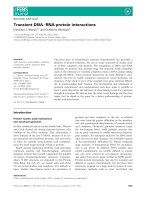
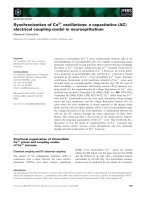
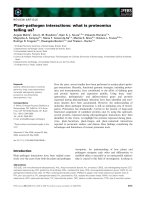
![Tài liệu Báo cáo khoa học: The stereochemistry of benzo[a]pyrene-2¢-deoxyguanosine adducts affects DNA methylation by SssI and HhaI DNA methyltransferases pptx](https://media.store123doc.com/images/document/14/br/gc/medium_Y97X8XlBli.jpg)
